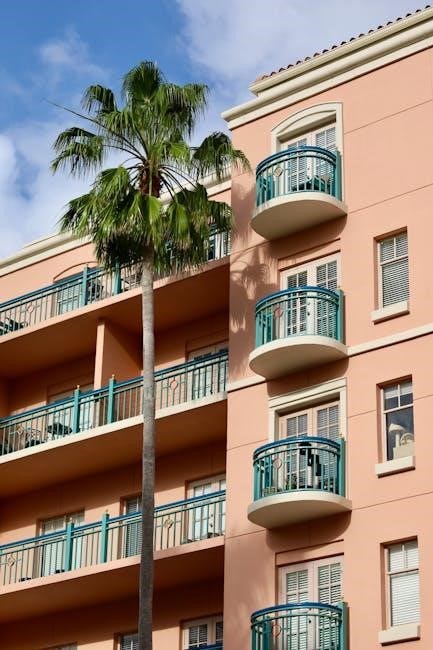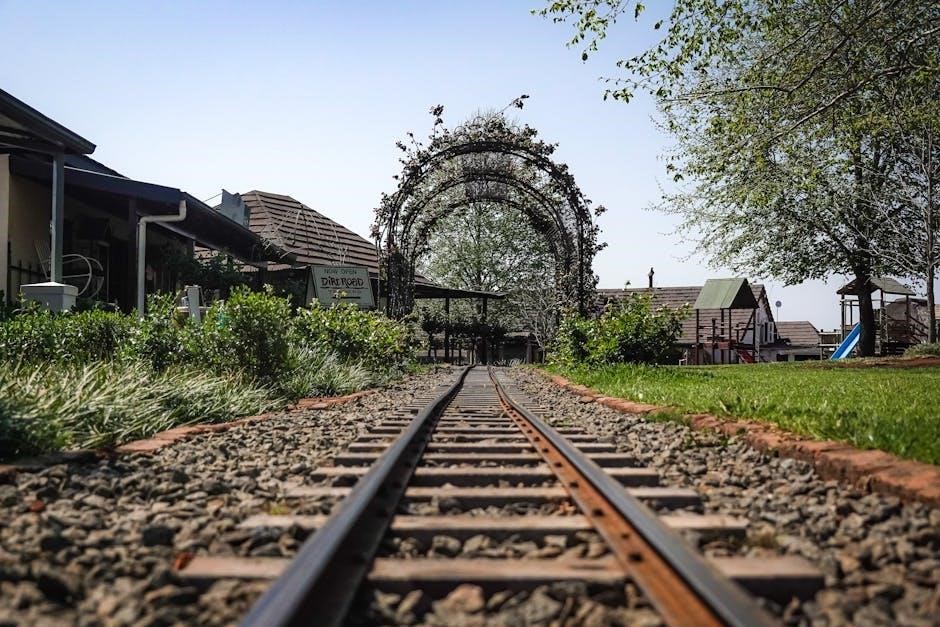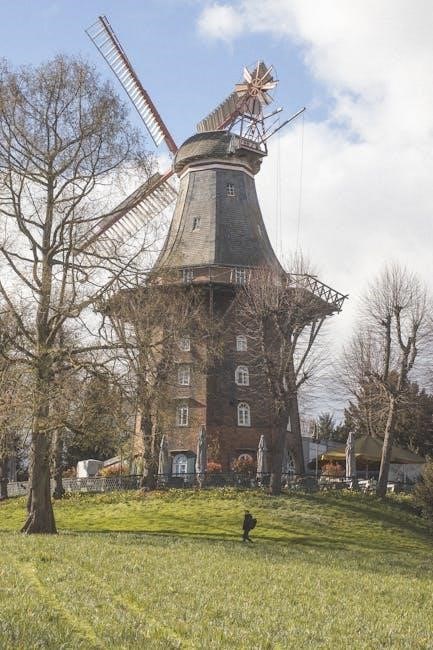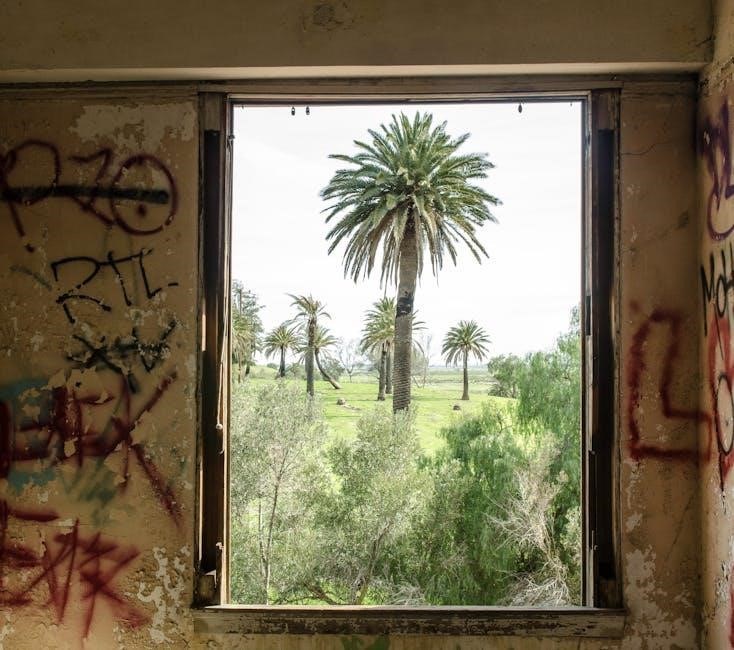Palm Springs is renowned for its rich mid-century modern architecture, offering a unique blend of desert modernism and iconic designs that attract global enthusiasts and celebrities alike.
Overview of Mid-Century Modern Architecture
Mid-century modern architecture, popularized in the 1930s to 1960s, emphasizes clean lines, minimal ornamentation, and seamless integration with natural landscapes. In Palm Springs, this style thrived, blending indoor-outdoor living with desert vistas. Large windows, open floor plans, and innovative use of materials like steel and glass define these structures. Influential architects such as Albert Frey and Donald Wexler pioneered this movement, creating iconic homes and buildings that reflect the era’s design philosophy. The style’s emphasis on functionality and harmony with the environment has made it a cornerstone of Palm Springs’ architectural identity, attracting global admiration and inspiring contemporary designs.

Preparing for Your Self-Guided Tour
Download maps, apps, and guides for navigating Palm Springs’ iconic architecture. Plan your route, check accessibility, and allocate 2-3 hours for the essential landmarks and neighborhoods.
Essential Materials: Maps and Apps
For a seamless self-guided tour, equip yourself with detailed maps and apps. Download printable guides from websites like visitpalmsprings.com or use apps like Google Maps for real-time navigation. Many platforms offer curated routes highlighting iconic mid-century modern homes and landmarks. Carry a physical map as a backup, especially in areas with limited internet access. GPS-guided tours are also available, providing historical insights and architectural details. Combine digital tools with printed materials for a comprehensive exploration of Palm Springs’ architectural gems. Ensure your devices are fully charged, and consider downloading offline versions of maps to stay connected throughout your journey.

Notable Architects and Their Works
Palm Springs boasts iconic designs by architects like Richard Neutra and E; Stewart Williams, whose innovative styles define the city’s architectural landscape and cultural identity.
Albert Frey and Donald Wexler: Pioneers of Desert Modernism
Albert Frey and Donald Wexler were pivotal figures in shaping Palm Springs’ architectural identity. Frey, known for his integration of nature and structure, designed iconic buildings like the Aerial Tramway Valley Station. Wexler, a master of steel construction, created the groundbreaking Steel Development Houses. Their work embodies Desert Modernism, emphasizing minimalism, functionality, and harmony with the desert landscape. These pioneers’ designs continue to inspire architects and captivate visitors on self-guided tours, showcasing their enduring influence on modernist architecture in Palm Springs.

Exploring Iconic Neighborhoods
Twin Palms and other historic districts showcase Palm Springs’ mid-century modern gems, offering scenic drives through neighborhoods rich in architectural history and preserved design excellence.
Twin Palms and Other Historic Districts
Twin Palms, a historic neighborhood, epitomizes mid-century modern design with its iconic homes by E. Stewart Williams and Donald Wexler. Other districts like Old Las Palmas and Movie Colony also feature architectural masterpieces, reflecting Palm Springs’ rich cultural heritage. These neighborhoods are a testament to the city’s status as a hub for innovative design, offering visitors a chance to explore and appreciate the timeless elegance of desert modernism through self-guided tours.
Cultural and Historical Significance
Palm Springs’ architecture mirrors its storied past, blending mid-century modernism with Hollywood glamour, attracting celebrities and architects who shaped its cultural identity as a design haven.
Architecture’s Role in Palm Springs’ History and Celebrity Appeal
Palm Springs’ architectural landscape played a pivotal role in its rise as a celebrity haven. The mid-century modern designs, with their sleek lines and desert-friendly aesthetics, attracted Hollywood stars like Marilyn Monroe, who sought privacy and luxury. Architects such as Albert Frey and Donald Wexler crafted homes that became symbols of the city’s glamorous lifestyle. These structures not only reflected the era’s design innovation but also housed legendary parties and gatherings, embedding Palm Springs into Hollywood’s history. The city’s architecture became a magnet for stars, forever linking it to the Golden Age of Hollywood;
Distinctive Architectural Styles
Palm Springs is celebrated for its mid-century modern and desert modernism designs, featuring clean lines, asymmetrical frames, and seamless indoor-outdoor living that harmonize with the desert landscape.
Characteristics of Desert Modernism
Desert Modernism in Palm Springs is defined by its minimalist aesthetic, emphasizing clean lines, minimal ornamentation, and a seamless connection between indoors and outdoors. Large windows and sliding glass doors dissolve boundaries, integrating the desert landscape into living spaces. The use of natural materials like stone and wood, combined with innovative prefab techniques, creates a harmonious balance with the arid environment. Open floor plans and functional simplicity reflect the era’s focus on modern living, while the incorporation of shaded terraces and pools addresses the desert climate. These designs embody both elegance and practicality, making Desert Modernism a timeless architectural phenomenon.

Key Historical Landmarks
The Kaufmann House, designed by Richard Neutra, is a landmark of mid-century modern architecture. Explore this iconic property and other historic gems that define Palm Springs’ architectural legacy.
Kaufmann House and Other Architectural Gems
Among the most celebrated properties in Palm Springs, the Kaufmann House stands out as a masterpiece of mid-century modern design. Built by Richard Neutra in 1947, this house epitomizes the harmonious integration of architecture with its desert surroundings. Its clean lines, minimalist aesthetic, and innovative use of glass create a sense of transparency and connection to nature. Visitors on a self-guided tour can admire its iconic silhouette and explore other nearby architectural gems, each offering a unique perspective on the evolution of modernist design in the region.

Modern Influences and Adaptations
Contemporary architects in Palm Springs blend mid-century modern principles with sustainable practices, incorporating energy-efficient designs and innovative materials while preserving the iconic desert modernist aesthetic and functionality.
Contemporary Design in Palm Springs
Contemporary design in Palm Springs seamlessly merges mid-century modern principles with cutting-edge innovation. Architects incorporate sustainable materials, energy-efficient systems, and open layouts while maintaining the iconic desert modernist aesthetic. Many new constructions emphasize indoor-outdoor living, blending seamlessly with the arid landscape. These designs cater to modern lifestyles, offering sleek, functional spaces that honor the region’s architectural legacy. Self-guided tours reveal how contemporary homes adapt timeless styles to current needs, ensuring Palm Springs remains a hub of architectural evolution and inspiration for global design enthusiasts.

Creating a DIY Itinerary
Plan your self-guided tour with a structured route, including a printable map and directions. Explore iconic homes, such as the Kaufmann House, at your own pace. Ideal for a 2-3 hour journey, this tour covers 22 miles of architectural gems, perfect for extended visits and return trips.
Structured Route with Printable Directions
A self-guided architecture tour of Palm Springs can be effortlessly planned with a structured route and printable directions. The tour spans 22 miles, covering iconic neighborhoods like Twin Palms and Indian Canyons. Highlighted stops include the Kaufmann House and other mid-century modern gems. Printable maps and Google Maps links provide easy navigation, ensuring you don’t miss any architectural landmarks. Ideal for a 2-3 hour exploration, this DIY itinerary is perfect for extended visits, allowing you to revisit favorite spots. Start early, wear comfortable shoes, and enjoy the city’s architectural treasures at your own pace.

Sustainability in Design
Palm Springs’ mid-century modern architecture emphasizes sustainability, incorporating energy-efficient designs and locally sourced materials to harmonize with the desert environment, showcasing eco-friendly principles in iconic buildings.
Energy Efficiency and lokal Materials
Mid-century modern architects in Palm Springs prioritized energy efficiency and the use of lokal materials, blending seamlessly with the desert environment. Large windows and sliding glass doors were strategically placed to maximize natural light and ventilation, reducing the need for artificial lighting and cooling. Materials like steel, glass, and desert stone were commonly used for their durability and ability to withstand the harsh desert climate. These sustainable practices not only minimized environmental impact but also created timeless, harmonious designs that continue to inspire contemporary architects. The Kaufmann House, designed by Richard Neutra, is a prime example of such innovative design.
Exploring Celebrity Homes
Discover iconic residences once owned by stars like Marilyn Monroe and Elvis Presley, showcasing Palm Springs’ architectural allure and its historic appeal as a celebrity retreat.
Marilyn Monroe and Other Star-Studded Residences
Marilyn Monroe’s former home in Palm Springs is a highlight for many architecture enthusiasts, offering a glimpse into the glamorous lives of Hollywood legends. Other celebrity residences, such as those once owned by Elvis Presley and Frank Sinatra, showcase the city’s mid-century modern charm. These homes, designed by renowned architects like Albert Frey and Donald Wexler, blend seamlessly into the desert landscape while exuding luxury and sophistication. Visitors can explore these iconic properties, admiring their sleek lines, expansive glass walls, and timeless designs that reflect Palm Springs’ status as a haven for stars and architectural innovation.

Planning and Navigation Tools
Google Maps and printable guides are essential for navigating Palm Springs’ architectural gems, providing detailed routes and directions to iconic homes and landmarks efficiently.
Utilizing Google Maps and Printable Guides
Google Maps and printable guides are indispensable tools for a seamless self-guided architecture tour in Palm Springs. These resources provide detailed routes, directions, and descriptions of iconic homes and landmarks. Google Maps offers real-time navigation, ensuring you never lose your way, while printable guides give a tactile alternative for those who prefer physical copies. Both options allow visitors to explore at their own pace, covering essential sites like the Kaufmann House and celebrity homes. These tools are especially useful for extended visits, as they offer reusable directions for multiple trips within a year. They enhance the overall touring experience, making it both efficient and enjoyable.
